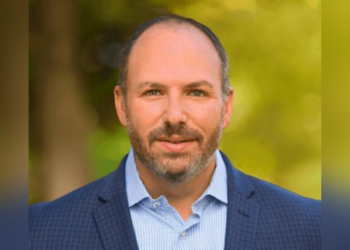TANGIER ISLAND, Virginia (Thomson Reuters Foundation) – James “Ooker” Eskridge’s family – like those of many of his neighbors – has lived on this isolated island in Virginia’s Chesapeake Bay for generations.
But its long traditions, which include crabbing and oystering in the surrounding waters, are under threat as Tangier Island gradually loses land as rising seas and stronger storms swallow the shoreline.
As he nudges a borrowed boat around its shores, Eskridge, Tangier Island’s mayor, points out a waterfront perch for osprey – a type of fish hawk – he put up five years ago. At that time it sat half a football field’s length inland from the shore.
“Now look at it,” Eskridge says with a laugh. “Probably one more year and that will go into the water.”
As its habitable upland areas disappear – 60% have gone since 1967, and at an accelerating rate over time, a November study https://www.frontiersin.org/articles/10.3389/fclim.2021.779774/full found – the population of Tangier Island also has been slowly eroding. Today just 400 or so people remain.
Researchers predict many more may need to leave in as little as a decade’s time as climate change drives wetlands inland.
Dave Schulte, a marine biologist with the U.S. Army Corps of Engineers and an author of the new study, projects that Tangier’s eastern Canton Ridge area will become a wetland by 2051, while Main Ridge will last until about 2035 and West Ridge only until 2033, if recent trends continue.
In the middle of one yard on the eastern side of the island, Zehao Wu, another author of the study, points to fiddler crab holes, a clear indication of a rising water table.
Eskridge and other residents hope to confront the rising tide and keep their homes using a battery of new seawalls – a proposition that would likely require substantial government help and raises key questions about what land is worth saving.
Their fight may be a preview of battles likely to play out for decades along low-lying coastal areas of the United States – and many other countries – as climate change drives warmer, rising seas and wilder storms.
Cameron Evans, a Tangier native and now a student at Virginia Wesleyan University, says he hopes the island can be saved and that it could become a model for other coastal rescues.
“If you can’t save an island a mile and a half long, how are you going to save the East Coast if sea level rise has become a factor?” asked Evans, a chronicler of island history.
SEA LEVEL RISE
Eskridge and other residents say constructing new seawalls along key spots, with possible assistance from the federal government and Virginia, could help stave off what researchers describe as nearly inevitable land losses.
Forecasters project that millions of people in similarly vulnerable coastal places in the United States and around the world will be forced to move inland in the coming years as their land is eaten by the sea.
The World Bank has projected https://www.worldbank.org/en/news/press-release/2021/09/13/climate-change-could-force-216-million-people-to-migrate-within-their-own-countries-by-2050 that more than 200 million people could be displaced by 2050 by sea level rise and other climate change impacts.
But Eskridge and others on the island blame erosion – not necessarily climate change or sea level rise – for Tangier’s problems.
“If we’re refugees, we’ll be erosion refugees,” said Eskridge, who supported former President Donald Trump and shares his skepticism about climate change threats.
Schulte and Wu’s study projected that relocating the town off Tangier Island – an option many residents fiercely resist – could cost between $100 million and $200 million.
Shoring up the island, by installing protective stone in vulnerable spots, using sand dredged from the bay to raise parts of the land, and making other infrastructure improvements, would cost $250 million to $300 million, they said.
They hope governments will step up to help with the hefty costs.
That would be “like a message from the government… to the rest of the country that says, ‘It doesn’t matter how little you are or how big you are – we’re not going to abandon you,’” Wu said.
But Eskridge believes a substantial seawall, capable of protecting much of the island, could be built for a fraction of those hundreds of millions of dollars.
A new stone jetty, erected within the last several years, cost only several million dollars, he noted. He said acceptable solutions wouldn’t have to restore lost land, only stop further losses.
“We’re just happy if they’ll save what we got now,” the mayor said.
FIRST SETTLERS
Many Tangier residents trace their roots as far back as the 1700s, after Captain John Smith first landed there in 1608.
That rich tradition is one reason people feel so strongly their land should be protected.
“We’re talking about saving a culture, the people, (a) way of life – the whole package,” Eskridge told the Thomson Reuters Foundation.
Local watermen put in grueling hours to help Tangier live up to its reputation as the soft-shell crab capital of the world.
During the peak summer crabbing season, Ooker says he gets up by 3 am to work.
“During the oyster season (in the winter), you can sleep in. You don’t have to get up until like 4:30 or 5,” he quipped.
But Tangier is tiny, with just one combined primary and secondary school, two churches, and a single main grocery store. Many residents get around the island by golf cart.
Plenty bitterly oppose relocation from the island – though some younger people are leaving for other opportunities, in part as state regulations make it difficult to secure the proper licensing to become a waterman.
Inez Pruitt, a physician assistant who runs Tangier’s lone medical clinic, shakes her head before a question about leaving the island can even be completed.
“Not going anywhere,” said Pruitt, who can trace her family’s roots back to the 1700s.
“I tell people the likelihood of finding someone in Williamsburg with the DNA of the first settlers is slim-to-none,” she said, referring to the early U.S. settlement on Virginia’s mainland.
“But you can trace us clear back to the beginning of Tangier.”
Eskridge isn’t quite sure what lies ahead for his own family.
As he steers a boat around Uppards, a now-uninhabited spot north of the main part of town, the mayor ponders what it would take for him to relocate from Tangier.
“Man, I don’t know. I probably would go for the right amount of money, but then … I don’t know,” he said, gazing back inland.
“I would really miss this place.”
(Reporting by David Sherfinski. Editing by Laurie Goering. Please credit the Thomson Reuters Foundation, the charitable arm of Thomson Reuters, that covers the lives of people around the world who struggle to live freely or fairly. Visit http://news.trust.org)









